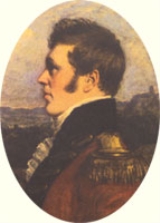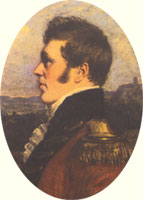
Richard Fletcher
Encyclopedia

British Army
The British Army is the land warfare branch of Her Majesty's Armed Forces in the United Kingdom. It came into being with the unification of the Kingdom of England and Scotland into the Kingdom of Great Britain in 1707. The new British Army incorporated Regiments that had already existed in England...
.
Fletcher served in the West Indies, being wounded in action during the capture of St. Lucia in 1791. During 1799 he took part in the preparation of the defences for the Turks
Turkey
Turkey , known officially as the Republic of Turkey , is a Eurasian country located in Western Asia and in East Thrace in Southeastern Europe...
in the Dardanelles. An expedition in 1800, to reconnoitre the Egyptian port of Alexandria, lead to his capture by the French navy; he was held prisoner until his release following the capture of Alexandria.
Returning to England in 1802, he was subsequently sent to fight in the Battle of Copenhagen
Battle of Copenhagen (1807)
The Second Battle of Copenhagen was a British preemptive attack on Copenhagen, targeting the civilian population in order to seize the Dano-Norwegian fleet and in turn originate the term to Copenhagenize.-Background:Despite the defeat and loss of many ships in the first Battle of Copenhagen in...
, before participating in the Peninsular War
Peninsular War
The Peninsular War was a war between France and the allied powers of Spain, the United Kingdom, and Portugal for control of the Iberian Peninsula during the Napoleonic Wars. The war began when French and Spanish armies crossed Spain and invaded Portugal in 1807. Then, in 1808, France turned on its...
as chief engineer, with the rank of lieutenant colonel, to General Sir Arthur Wellesley, 1st Duke of Wellington
Arthur Wellesley, 1st Duke of Wellington
Field Marshal Arthur Wellesley, 1st Duke of Wellington, KG, GCB, GCH, PC, FRS , was an Irish-born British soldier and statesman, and one of the leading military and political figures of the 19th century...
. He was responsible for building the celebrated Lines of Torres Vedras
Lines of Torres Vedras
The Lines of Torres Vedras were lines of forts built in secrecy to defend Lisbon during the Peninsular War. Named after the nearby town of Torres Vedras, they were ordered by Arthur Wellesley, Viscount Wellington, constructed by Sir Richard Fletcher, 1st Baronet and his Portuguese workers between...
, and also saw action at Bussaco
Battle of Buçaco
The Battle of Bussaco resulted in the defeat of French forces by Lord Wellington's Anglo-Portuguese Army, in Portugal during the Peninsular War....
, the sieges of Ciudad Rodrigo
Ciudad Rodrigo
Ciudad Rodrigo is a small cathedral city in the province of Salamanca, in western Spain, with a population of about 14,000. It is the seat of a judicial district as well....
and Badajoz
Badajoz
Badajoz is the capital of the Province of Badajoz in the autonomous community of Extremadura, Spain, situated close to the Portuguese border, on the left bank of the river Guadiana, and the Madrid–Lisbon railway. The population in 2007 was 145,257....
, taking a wound in the groin in the latter engagement.
He returned to England
England
England is a country that is part of the United Kingdom. It shares land borders with Scotland to the north and Wales to the west; the Irish Sea is to the north west, the Celtic Sea to the south west, with the North Sea to the east and the English Channel to the south separating it from continental...
to recover, and was made a baronet
Baronet
A baronet or the rare female equivalent, a baronetess , is the holder of a hereditary baronetcy awarded by the British Crown...
on 14 December 1812, and awarded a pension and the Army Gold Cross for Talavera, Bussaco, Ciudad Rodrigo, and Badajoz. He returned in 1813 and directed the sieges of Pamplona
Pamplona
Pamplona is the historial capital city of Navarre, in Spain, and of the former kingdom of Navarre.The city is famous worldwide for the San Fermín festival, from July 6 to 14, in which the running of the bulls is one of the main attractions...
and San Sebastián
San Sebastián
Donostia-San Sebastián is a city and municipality located in the north of Spain, in the coast of the Bay of Biscay and 20 km away from the French border. The city is the capital of Gipuzkoa, in the autonomous community of the Basque Country. The municipality’s population is 186,122 , and its...
. He was killed in action during the final assault on San Sebastián on 31 August 1813.
Though buried near San Sebastián, a monument to his memory stands at the western side of the north aisle in Westminster Abbey, London. His eldest son died without issue and one of his five daughters – Harriet – married the Rev. William Darwin Fox
William Darwin Fox
The Reverend William Darwin Fox was an English clergyman, naturalist, and a 2nd cousin of Charles Robert Darwin.- Early life :...
, a second cousin of Charles Darwin
Charles Darwin
Charles Robert Darwin FRS was an English naturalist. He established that all species of life have descended over time from common ancestry, and proposed the scientific theory that this branching pattern of evolution resulted from a process that he called natural selection.He published his theory...
.

